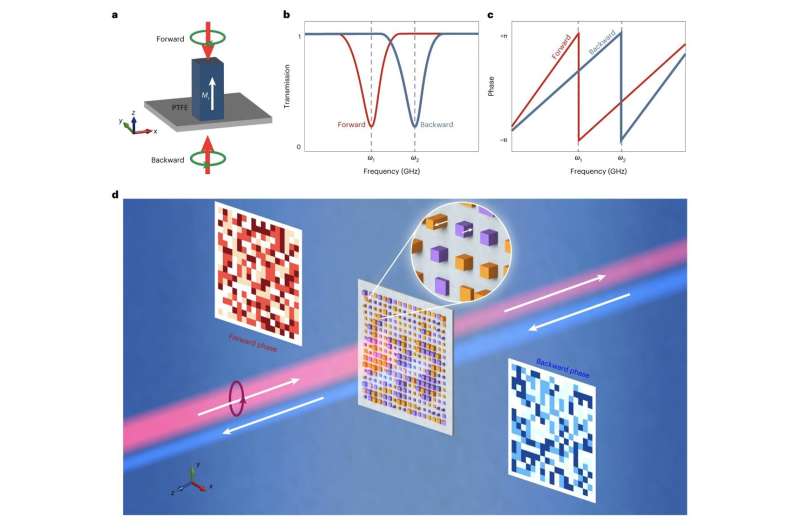A non-reciprocal metasurface based on magnetic meta-atoms
Metasurfaces, two-dimensional (2D) or planar versions of metamaterials exhibit properties that are not typically found in natural materials. As they are flat, these materials can typically be produced using widely known fabrication processes and may help to control the propagation of electromagnetic waves in various devices.
Most metasurfaces follow the rules outlined by the so-called Lorentz reciprocity theorem, which basically means that they exhibit characteristics that are symmetrically aligned to the direction of electromagnetic wave propagation. Non-reciprocal metasurfaces are an emerging class of metasurfaces that do not obey the Lorentz reciprocity theorem.
In contrast with conventional metasurfaces, non-reciprocal metasurfaces could encode optical functions on waves that are propagating both forward and backward. This key characteristic could make them particularly promising for the development of several technologies, including non-reciprocal antennas or protective structures known as radomes, which are designed to preserve the operation of radar antennas or wireless communication systems.
Researchers at the University of Electronic Science and Technology of China and Massachusetts Institute of Technology (MIT) recently developed a new non-reciprocal and magnetic metasurface that could provide be used to create new devices with various non-reciprocal functionalities. This metasurface, introduced in Nature Electronics, was created using a series of self-biased magnetic meta-atoms made of lanthanum(La)-doped barium hexaferrite (BaFe12O19).
“We report a self-biased non-reciprocal metasurface based on magnetic meta-atoms made from La-doped BaFe12O19,” Weihao Yang, Jun Qin and their colleagues wrote in their paper. “The metasurface offers a transmittance of up to 77% and an operation angle of ±64°.”
Essentially, each of the meta-atoms contained in the team’s non-reciprocal metasurface can be individually magnetized along different directions. Leveraging this key feature of their design, the researchers were able to engineer their metasurfaces to attain bidirectional, non-reciprocal phase-gradient profiles.
In initial experiments, they then showed that the resulting metasurfaces can enable a wide range of functionalities that could be advantageous for the creation of different devices and electronic components. For instance, they could be used to achieve electromagnetic wave isolation, circulation, and full-duplex transmission.
“We show that they can be used for on-demand bidirectional phase modulation, which provides non-reciprocal functionalities including microwave isolation, non-reciprocal beam steering, non-reciprocal focusing and non-reciprocal holography,” Yang, Qin and their colleagues wrote in their paper. “The approach could also be potentially extended to megahertz and optical frequencies by using different self-biased magnetic materials.”
In the future, the new non-reciprocal metasurfaces created by Yang, Qin and their colleagues could be used to develop new promising electronics, including non-reciprocal antennas and radomes. In addition, the innovative design they create could inspire other teams to create other similar metasurfaces based on self-biased magnetic meta-atoms.
In their next studies, the researchers could extend the operating frequency of their metasurfaces using different self-biased meta-atoms, potentially covering megahertz to optical wave frequencies. In addition, they plan to further improve the overall performance of devices based on their metasurfaces, for instance by reducing efficiency, insertion and reflection losses associated with their current design.
More information:
Weihao Yang et al, A self-biased non-reciprocal magnetic metasurface for bidirectional phase modulation, Nature Electronics (2023). DOI: 10.1038/s41928-023-00936-w
© 2023 Science X Network
Citation:
A non-reciprocal metasurface based on magnetic meta-atoms (2023, April 12)
retrieved 13 April 2023
from https://techxplore.com/news/2023-04-non-reciprocal-metasurface-based-magnetic-meta-atoms.html
This document is subject to copyright. Apart from any fair dealing for the purpose of private study or research, no
part may be reproduced without the written permission. The content is provided for information purposes only.

Comments are closed